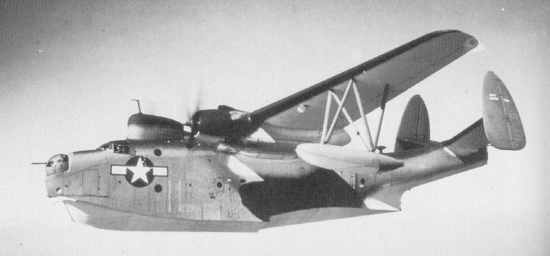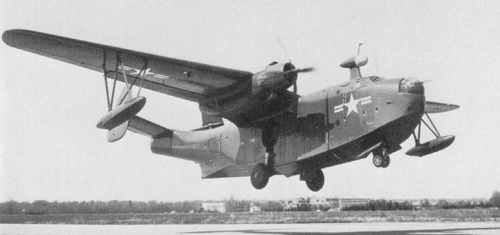Fighting the U-boats
Aircraft & Air forces
Martin PBM Mariner
prepared by Emmanuel Gustin

A PBM-3 Mariner in flight
In 1936 Martin offered the US Navy the design of a patrol-bomber flying boat, known as the Martin 162. The model 162 was an all-metal aircraft, with flush riveting. It had a deep fuselage, a gull wing to keep the two propellers well above the spray, and twin tailfins. The 162 had a two-step bottom. The wingtip floats retracted inwards. The 162 was much bigger and more advanced than the Consolidated PBY that was then entering service, so Martin first built a flying quarter-scale model, the Martin 162A, powered by a Pobjoy engine. Apparently it had a single engine, driving two propellers by gearing and extension shafts. The 162A flew in 1937.
The full-scale prototype, the XPBM-1, was ordered on 30 June 1937 and made its first flight on 18 February 1939. The Navy had already ordered 20 production aircraft, designated PBM-1. These entered service in 1940, and distinguished themselves from the prototype by a dihedralled tailplane. The tailplane now had the same dihedral as the wing centre section; the tailfins remained orthogonal to the tailplane, and this gave the tail a toed-in appearance which was an easy recognition feature. The PBM-1s were powered by 1600hp Wright R-2600-6 engines, and had a crew of seven. The defensive armament included nose and dorsal turrets, a gun position in the extreme tail, and beam guns. The aircraft could carry 907kg of bombs, which were stored in the aft part of the engine nacelles.
The PBM-2 was an experimental long-range version, which was strengthened to be launched by catapult. This version did not enter production.
The next production version was the PBM-3. They had 1700hp R-2600-12 engines, more armament, more fuel, and a crew of nine. The vulnerable retractable stabilizing floats were replaced by fixed ones. The first 50 ones were completed as PBM-3R transports, without military equipment. The PBM-3C combat model had search radar in a dorsal bulge, just aft of the flight deck. Crutches under the wing roots could carry 21-inch torpedoes. Power-operated turrets in the nose, tail and dorsal position now each had two .50 guns. This version appeared in September 1942. The PBM-3D had 1900hp R-2600-22 engines and even more armament. The engines nacelles had been extended, so that bomb load could be increased to 1814kg. The PBM-3S on the other hand, had decreased armament: Only four machineguns, all hand-held. This weight saving compensated for a larger fuel load, because the PBM-3S was a long-range antisubmarine aircraft.

A Martin PBM-5A Mariner. This was the only amphibious version of the Mariner.
The final version was the PBM-5, with 2100hp engines, increased fuel, and an APS-15 radar. This model made its first flight in May 1943. The Navy ordered 100, but because of the end of the war only 589 of these were completed. The final version was the PBM-5A amphibian, with retractable tricycle landing gear and R-2600-34 engines. The last Mariner was delivered in April 1949.
The crew of the Mariner benefitted from sound-proofing, heating, ventilation, a galley, and fold-down bunks. The galley even included a refrigerator, a water heater and an electrical stove. Crew comfort was important on long patrol flights. The Mariner carried the equipment needed for routine maintenance. It was a powerful and reliable aircraft, but the PBY Catalina became much more famous because it served in larger numbers during the first years of the war.
Total wartime production of the Mariner was 1289. Over 500 were still in frontline service during the Korean War. Foreign users included the RAF, although it used only 25, and only for half a year, and the RAAF, which had 12 PBM-3R aircraft.
Specifications
- Martin PBM-3 Mariner
- Engines:
- Two 1700hp Wright R-2600-12 Cyclones.
- Dimensions:
- Wing span 35.96m, length 24.38m, height 8.38m, wing area 130.75m2.
- Weights:
- Empty weight 15050kg, normal take-off weight 23280kg, max weight 26310kg.
- Performance:
- Maximum speed 314km/h at sea level, 319km/h at 3960m.
Climb to 3000m in 22.2min, service ceiling 6000m.
Range 3600km. - Armament:
- Seven .50 machineguns and 907kg of bombs.
Sources
- From three to two -- Australian use of the Do 24 and PBM-3
James Ritchie Grant
Air Enthusiast No.64, July-August 1996. - The illustrated history of Seaplanes and Flying Boats
Louis S. Casey and John Batchelor
Hamlyn, 1980 - Water- en transportvliegtuigen -- Wereldoorlog II
Bart van der Klaauw
De Alk - Plane Facts
Air Enthusiast, August 1972
Selected media links
|



